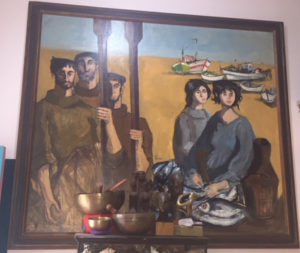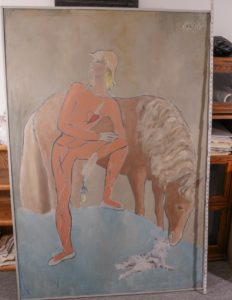 PL sent me a painting by Jose Luis Figueroa (1925 – ) of Portuguese fishermen and fisherwomen. A large-scale painting which depicts a delightful touch, a pregnant fisherwoman with her gleaming basket of fish. The style points to mid 20th century. Although not classically mid-century modern, the painting references the School of Paris, a lesser-known genre of the mid-20th century, featuring characters with wistful, soulful faces. I contrast this with a painting by Marcel Vertes (1895-1961). Also large (67” x 45”), this painting of the same genre and era, comes to me from FH, who hopes to find a buyer. This era, (1940- 1960), of figure painting fell out of favor until very recently when we see well deserved growing interest today.
PL sent me a painting by Jose Luis Figueroa (1925 – ) of Portuguese fishermen and fisherwomen. A large-scale painting which depicts a delightful touch, a pregnant fisherwoman with her gleaming basket of fish. The style points to mid 20th century. Although not classically mid-century modern, the painting references the School of Paris, a lesser-known genre of the mid-20th century, featuring characters with wistful, soulful faces. I contrast this with a painting by Marcel Vertes (1895-1961). Also large (67” x 45”), this painting of the same genre and era, comes to me from FH, who hopes to find a buyer. This era, (1940- 1960), of figure painting fell out of favor until very recently when we see well deserved growing interest today.
School of Paris
The fused traditions of many nationalities of artists came together to paint, socialize, and share ideas, in the Montmartre and Montparnasse districts of Paris. All absorbed the main artistic, early 20th century challenge of rebellion against the kind of art taught in the Academies of the time. The effect of this style lasted until the 1960’s.
School of Paris painters reinvented the human form in the early part of the 20th century. Instead of portraying the heroes, gods, and beauties required in the Art Academies, these artists depicted the middle class, the alienated, wistful children and other outsiders, and figures drawn from circus and theater. In the second wave of School of Paris painters, a portrayal of the human figure became cliché and sometimes appears as borderline kitsch.
From the sublime to the ridiculous
 One recurrent theme of the early 20th century continued in the midcentury is the French harlequin. Picasso himself painted 50 canvases that featured his alter-ego, the Pierrot harlequin. Later in the century (1940’s – 60’s), we see harlequin lamps, mass-produced prints, and costume jewelry boasting this figure. The harlequin, a melancholy clown, originated in France in 13th century passion plays. Painters loved his costume of triangular colorful patches, mask, and pointed beard. He performed in various guises as an acrobat, a trickster, a young devil, a cuckholded lover, making his way through the theatrical history of Europe, especially notable in the Italian commedia dell’arte, and later, French pantomime. By 1940’s – 60’s, people associated the figure with anything French, which meant ‘anything artistic!’
One recurrent theme of the early 20th century continued in the midcentury is the French harlequin. Picasso himself painted 50 canvases that featured his alter-ego, the Pierrot harlequin. Later in the century (1940’s – 60’s), we see harlequin lamps, mass-produced prints, and costume jewelry boasting this figure. The harlequin, a melancholy clown, originated in France in 13th century passion plays. Painters loved his costume of triangular colorful patches, mask, and pointed beard. He performed in various guises as an acrobat, a trickster, a young devil, a cuckholded lover, making his way through the theatrical history of Europe, especially notable in the Italian commedia dell’arte, and later, French pantomime. By 1940’s – 60’s, people associated the figure with anything French, which meant ‘anything artistic!’
We see remnants of the soulful eyed lover in PL’s work by Jose Luis Figueroa, also known for his wistful images of harlequin figures, the trickster outsider, a Frenchified mute with a youthful body. Many, many artists painting after Picasso took up this theme. Often, the harlequin has a female counterpart, Columbine (you’ll see Pierrot and Columbine figures from this era made into kitschy lamps) and indeed, in pantomime, harlequin is a romantic ‘common man’s figure, his mystique lasting even today.
PL does not know the date of his painting
I place it right after WWII, when a great artists’ battle had been fought between the Abstract Expressionists and the more palatable for the masses figure-painters. In the 1920-40s, buyers tended to buy the figure-paintings. Only the connoisseurs and forward thinking collectors of this period bought Expressionism. The second wave, the glorification of anything FRENCH, relied on the first School of Paris for its artistic cache. Expressionism as a genre is priced beyond belief at auction today while figurative work of lesser artists of the period goes for a song. Expressionism looked forward to a chaotic and abstracted future, a true reflection of the era to come. Conversely, figure paintings appeared nostalgic and easy on the eye.
Certain eras of painting have recognizable figures, such as the harlequin from 1900-1960. PL’s artist, Figueroa, and many late School of Paris painters painted children, clowns, animals, simple laborers, wistful and romanticized, on stage, as it were, the painting as some kind of performance piece. Look at the Vertes painting of the harlequin, which I place at $5,000-6,000.
The market for the late School of Paris figure paintings such as PL’s is gathering value, as they fall into a certain brand of cartoonish art such as those big-eyed waifs of Margaret Keane and the laughable clowns of Red Skelton. Yes, borderline kitsch, but well painted and usually easy to understand. They DO complement midcentury modern decorating schemes (all the rage), so prices for this School are rising in the market today.
I predict PL’s painting will increase in value from the present “track records” of this artist’s sales, at $2,500 to much more as this era becomes the next big thing.